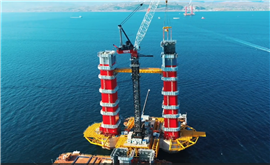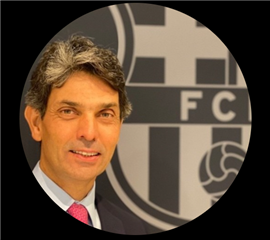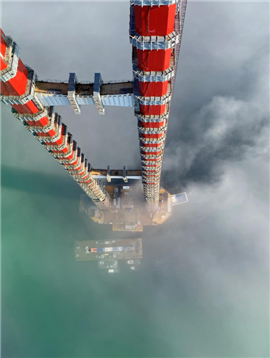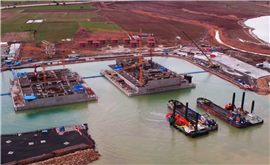Video: Engineering takeaways from a record-breaking suspension bridge
04 December 2023
Resit Yildiz is a director of projects at Limak, one of Turkey’s largest contractors.
The company has a fast-growing reputation for delivering mega projects on time and within budget – something of a rarity within today’s European construction arena.
The successful completion of large endeavours such as Istanbul airport (as part of the IGA consortium) and the Yusufeli Dam (as main contractor) was not lost on FC Barcelona, which this year offered Limak the contract to increase the capacity of its legendary Camp Nou football stadium to over 100,000 spectators.
This project is now well underway and Limak has publicly stated its confidence in completing the project within its projected timeframe.
Resit Yildiz, who is now working on the Camp Nou project, was also the engineer responsible for delivering the 1915Çanakkale suspension bridge in northwestern Turkey – which boasts firsts including the longest-ever central span.
He recently spoke to Construction Europe about the enormous engineering challenges he and his team had to overcome during its four-year construction process.
Less than auspicious timing
“This was a very long journey for us,” he said, “although the construction phase itself only lasted four-and-a-half years. It took 17,000 people’s efforts to construct the bridge.”
One of the biggest challenges Yildiz faced during that time was not an engineering one, but the need to maintain round-the-clock operations throughout Covid lockdown, to ensure timely delivery of the project.
 The towers of the 1915Çanakkale suspension bridge under construction (Image: Limak/Resit Yildiz)
The towers of the 1915Çanakkale suspension bridge under construction (Image: Limak/Resit Yildiz)
Yildiz had to, in effect, impose a lockdown among his own design and construction teams – and to ensure everyone was on board with the plan. He himself lived on site, immersing himself completely in the work.
He says the need to complete projects such as this quickly is more than a matter of pride – it’s simple maths.
The BOT (build, operate and transfer) contract gives Limak a total of 16 years in control of the bridge.
A rapid four-year construction period has left the company 12 years to recoup costs from tolls. Any delay in delivery of the bridge would have directly impacted the bottom line.
No pressure then, on a project that delivers world firsts including the longest-ever central span and the tallest suspension towers – not to mention some of the heaviest-ever floating lifts for a suspension bridge.
Talking to Yildiz, it seems clear that the placement and structural integrity of the towers was crucial to the success of the project.
So many firsts
The Çanakkale bridge is incredibly long, at 4.6km, but more importantly is has the longest central span of any suspension bridge in the world, at 2,023m.
 Limak’s director of projects, Resit Yildiz (Image: Limak/Resit Yildiz)
Limak’s director of projects, Resit Yildiz (Image: Limak/Resit Yildiz)
A span of this magnitude would bring any engineer out in a cold sweat, but the Çanakkale bridge was designed to span the Dardanelles Strait, notable for powerful currents and strong winds.
Given these factors, Yildiz says, “You can’t just lay down the foundations on the seabed; you have to make a lot of preparations, and each foundation footprint is equal to the area of a soccer field at 74m by 83m.
“The heights are also massive – 25m – which is about the height of an eight-storey building.”
It’s also worth noting that under these foundations are huge piles, 2.5m in diameter and 46m in length – almost all of which had to be hammered down beneath the seabed.
Yildiz says, “We used different technologies – such as the biggest hydraulic hammer in the world that could operate underwater – to drive the piles. In fact, many of the technologies we used on this bridge were the biggest in the world.
“For example, the heavy lifting cranes that constructed the towers were the largest, in terms of both height and lifting capacity – and they did not exist before this project; they were specifically designed and manufactured for the bridge.”
Challenges on dry land
Taking a step back, to the early stages of the project, it’s worth considering the construction of the dry dock, which, at 266m by 198m, was approximately the size of four football pitches.
This entire area had to be excavated to a depth of between 9.5m and 10.5m.
In this sunken ‘arena’, the two bridge caissons – one for the tower on the European side, the other for the Asian side – were partially constructed.
Once completed, the two caissons had a combined weight of 99,000 tonnes and required a combined volume of 37,000m3 of concrete.
With the caissons completed, water was allowed into the sunken area, allowing the caissons to rise to the level of the Dardanelles Strait.
Yildiz says this was one of the most critical and nail-biting moments of the project. “It’s important that you make your calculations very precisely,” he says, “because if you make any mistake, despite filling the dry dock with water, they [the caissons] will not float, you will not be able to tow them away and the effort will be totally wasted.”
We have lift off
 1915Çanakkale has the tallest towers of any suspension bridge, at 334m (Image: Limak/Resit Yildiz)
1915Çanakkale has the tallest towers of any suspension bridge, at 334m (Image: Limak/Resit Yildiz)
He remembers very well the day of the dry dock’s water inundation. “Even though we had the best engineers and we had done all the calculations, we were all very nervous on the day,” he says.
“The Asian caisson is over 51,000 tonnes and the other is almost 50,000 tonnes and all of us spent the whole day waiting for them to float. Then one of our surveyors said one of the corners was up by a millimetre.”
It seems something of an understatement when Yildiz concludes, “We were at that point a bit relieved that the rest would come.”
From there, you might say, it was plain sailing…
The barrier between the dry dock and the open sea was demolished, allowing the concrete behemoths to be towed by four tugs out to the newly-constructed wet dock. Here, construction of the now floating caissons could be completed.
Meanwhile, dredging of the seabed was undertaken, in preparation for insertion of the caisson piles.
With the piles in place, gravel beds were laid and levelled, onto which each caisson was to be lowered, with centimetre precision.
The longest day
Yildiz says, “We used five vessels – four tug boats and the main control vessel. With pumps we filled the [caisson] chambers – very precisely and based on detailed calculations – with seawater.
“The whole operation lasted about 36 hours, to bring the caisson down to the seabed.”
In trying to describe the magnitude of this task, Yildiz says, “Imagine its massive size – the size of a soccer field. And imagine you’re at the centre of the soccer field and a spaceship is coming down, and its size is the same as the soccer field, and it has to land so precisely that your limitation is less than 20cm.”
If imagining this is difficult, imagine attempting it.
 The two bridge caissons are floated in dry dock, ready for towing out to sea. (Image: Limak/Resit Yildiz)
The two bridge caissons are floated in dry dock, ready for towing out to sea. (Image: Limak/Resit Yildiz)
For Yildiz, knowing that any error of more than 20cm meant the two sides of the bridge would not meet was enough to concentrate the mind.
To ensure that happened, he says, “We placed hydraulic pistons on the seabed, which we could control from the vessel.”
Using these pistons, the caisson’s movement towards the seabed could be strictly controlled.
“We could see the position of the caisson and the immersion team stopped it when it was 50cm above the seabed and asked for our confirmation,” says Yildiz. “We said ok, you can touch down.”
With the caissons in position, the tower segments were floated out and placed, using a climbing crane.
Now the anchor blocks could be constructed on either bank, before the main cables were run through the towers.
With main cables secured, 1915Çanakkale really began to take on that classic suspension bridge shape.
There was still the small matter of thousands of metres of cabling and the immense task of raising and securing deck sections, but the Dardanelles crossing was at this point assured.
STAY CONNECTED



Receive the information you need when you need it through our world-leading magazines, newsletters and daily briefings.
CONNECT WITH THE TEAM








